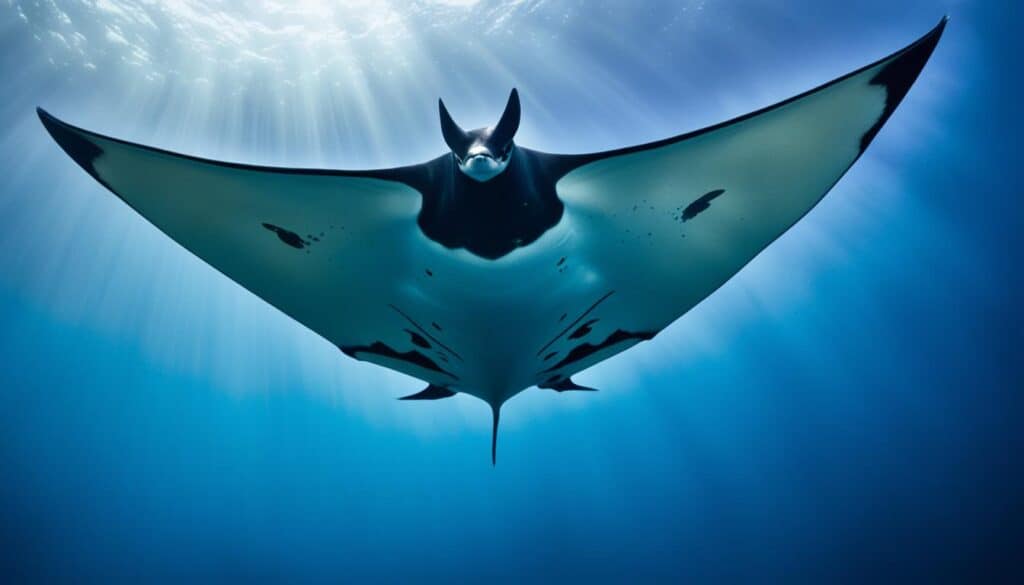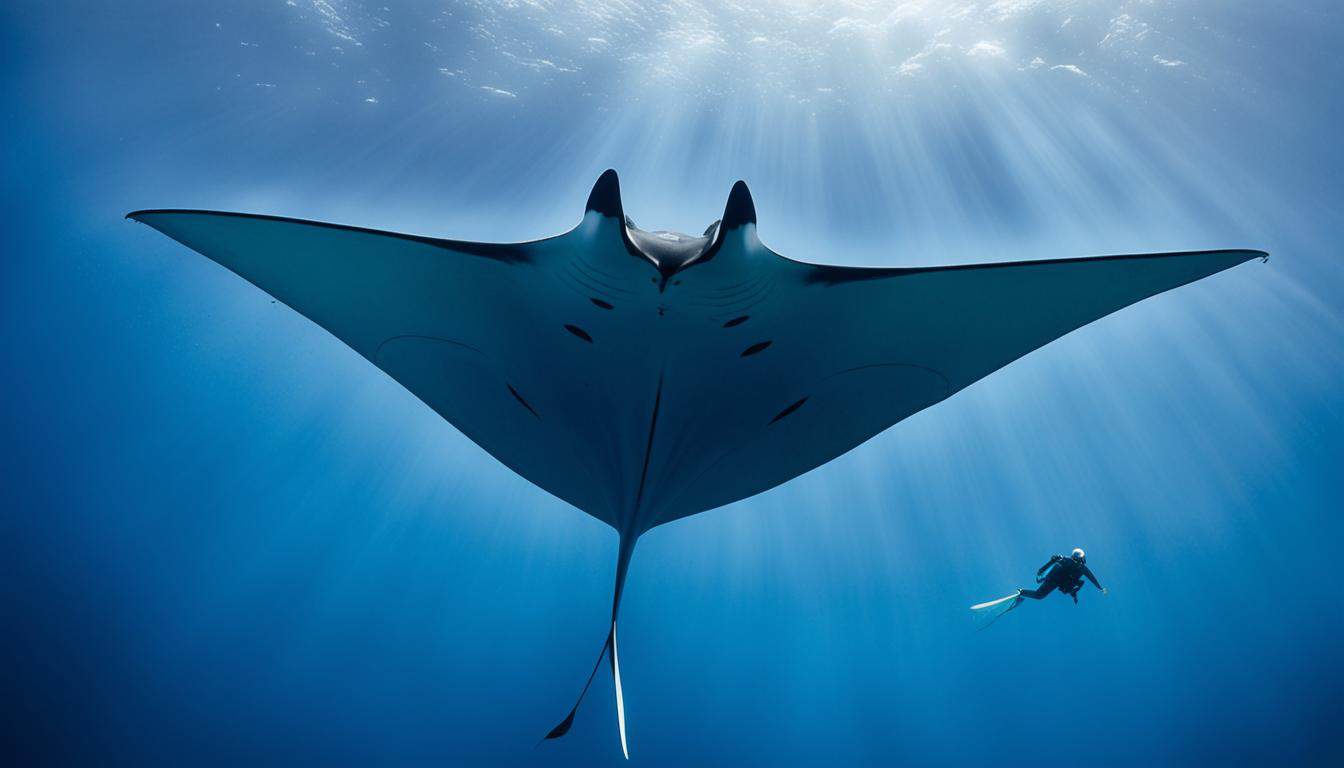Manta rays are known as the “gentle giants of the sea” for their graceful movements in the ocean. You might ask, how do these gentle giants protect themselves in the vast ocean? Unlike many sea creatures with sharp teeth or venom, manta rays use special manta ray defense mechanisms. These include their size, speed, and how they behave.
By learning about these tactics, we understand how they survive and their role in keeping the ocean healthy. Their ways of avoiding danger and protecting themselves show us why we need to save these amazing creatures.
Introduction to Manta Rays and Their Defense Mechanisms
Manta rays are amazing creatures with unique manta rays characteristics. They are part of the class Chondrichthyes, which also includes sharks. These gentle giants can grow up to 22 feet wide. They eat plankton and krill, showing how they’ve adapted to ocean life.
Some people mix them up with stingrays, but they’re quite different. Manta rays don’t have barbs or stingers, so they’re safe around humans. Knowing how they defend themselves is key. They use various strategies to avoid predators.
Being big and fast helps them stay safe in the water. Manta rays move quickly and dodge threats easily. They also learn from past experiences, making them smarter at staying safe. This shows how complex their defense strategies are.
| Characteristic | Details |
|---|---|
| Class | Chondrichthyes |
| Wingspan | Up to 22 feet |
| Feeding Habits | Plankton and krill |
| Defense Mechanisms | Size, speed, learned behavior |
Understanding Manta Ray Predators
Manta rays live in the ocean’s vast and tough environment. They face many manta ray predators. Large sharks like tiger sharks and hammerhead sharks, and orcas, are some of these predators. Orcas are smart and hunt together.
These predators are big and skilled at hunting. They are a big threat to manta rays. Manta rays need to be fast to avoid these dangers.
Learning about predators of manta rays helps us understand marine ecosystems better. It makes us appreciate manta rays and the balance in their homes.
| Predator | Characteristics | Impact on Manta Rays |
|---|---|---|
| Tiger Shark | Powerful, aggressive hunters | Threatens adult and juvenile manta rays |
| Hammerhead Shark | Unique head shape enhances hunting | Can target manta rays effectively during hunts |
| Orca | Highly intelligent, social predators | Utilizes teamwork to capture manta rays |
How do manta rays defend themselves?
Manta rays have special ways to keep safe in the water. They use different strategies and tactics to boost their survival chances.
Manta ray protection strategies
Manta rays are big, which helps them defend against smaller predators. Their large size can scare off potential threats. They also swim fast and make sharp turns to get away from danger.
This behavior helps them avoid being caught. It’s a smart way for manta rays to protect themselves.
Manta ray self-defense tactics
When needed, manta rays use special defense moves. They swim erratically to confuse predators. This makes it hard for attackers to catch them.
This shows how smart and adaptable manta rays are when facing danger. They use their size and smart moves to stay safe in the water.
Manta Ray Behavior in Response to Threats
Manta rays have amazing ways to stay safe when threatened. When predators come near, they change how they swim. They quickly change direction and speed up. This helps them avoid being caught.
They also like to swim with others. Being in a group gives them more protection. When they move together, it’s hard for predators to target them. They also jump out of the water, which can distract predators. These actions show how manta rays stay safe in the ocean.

Manta Ray Escape Tactics: Speed and Agility
Manta rays have amazing skills that help them survive in the ocean. They are fast and agile, which is key to their defense. With big, strong pectoral fins, they move quickly to avoid danger.
The importance of maneuverability in defense
Being able to move quickly is crucial for manta rays. They don’t have armor or poison to protect themselves. Instead, they use speed and agility to get away from predators. Their bodies are made to change direction fast, helping them dodge obstacles and avoid being caught.
How aerial displays help manta rays evade predators
Aerial displays are two things for manta rays. They jump out of the water and do flips, which is both beautiful and a way to escape. These actions distract and confuse predators, making it harder for them to attack. Plus, these displays help get rid of parasites, showing another way their escapes are useful.
Manta Ray Camouflage Techniques
Manta rays have unique ways to hide from predators. Their color helps them survive. They have a dark top and a light bottom. This helps them blend in with the ocean’s depths and the sunlight above.
How coloration plays a role in avoiding detection
Their dark top makes them hard to see in deep water. The light underbelly reflects sunlight, making it hard for predators to spot them from below. These manta ray camouflage techniques help them stay safe in their home.
Manta rays vs. their predators: the hide-and-seek strategy
Manta rays also stay still to hide better. By not moving, they’re harder to see. This way, they can hide well and avoid danger.
| Technique | Description |
|---|---|
| Coloration | Dark upper side and lighter lower side to blend with surroundings |
| Stillness | Remaining motionless to avoid detection from predators |
| Environmental Awareness | Utilizing surroundings such as reefs and shadows for added camouflage |
These strategies make manta ray camouflage techniques very effective in their ocean home.
The Role of Size in Manta Ray Defense
The size of manta rays is key to their survival in the ocean. Their large wingspans, often over 20 feet, help them defend against threats. This size can scare off many predators, who prefer not to tackle large prey. This natural defense keeps their predation rates low.
How their size deters potential threats
The impressive size of manta rays is not just for show. It actually helps them in the wild. Many predators won’t attack something much bigger than themselves. So, the large wingspan and body length of manta rays act as a strong defense. This size advantage boosts their safety and stability in their home.
Understanding the Social Behavior of Manta Rays in Defense
Manta rays live in groups, which helps them defend themselves. They often swim together, making it easier to spot dangers. This way, they can feed better and stay safe.
When danger comes, manta rays warn each other. This helps the group move away from predators. Being together makes them stronger and more likely to survive.
These social behaviors help manta rays adapt to their world. They don’t just hunt together; they also stay safe. Their group actions are key to their survival in the ocean.
FAQ
How do manta rays defend themselves from predators?
Manta rays use their size, speed, behavior, and camouflage to defend themselves. Their big wingspan scares off smaller predators. They swim fast and do acrobatics to avoid attacks.
What are the main predators of manta rays?
Large sharks like tiger sharks and hammerhead sharks, as well as orcas, threaten manta rays. Knowing about these predators helps us understand how manta rays defend themselves.
What self-defense tactics do manta rays use?
Manta rays use erratic swimming and quick changes in direction to confuse predators. This makes it easier for them to escape.
How does social behavior enhance manta rays’ defensive strategies?
Swimming in groups is key for manta rays. Being together makes them more aware of dangers and helps them warn each other. This increases their chances of staying safe.
How do manta rays use speed and agility as defense mechanisms?
Manta rays are very fast and agile in the water. They can quickly change direction to escape from predators.
What role does coloration play in manta ray defense?
Manta rays’ colors help them blend in with their surroundings. Their dark top and light bottom make them hard to see. This helps protect them from predators.
How does the size of manta rays serve as a defense mechanism?
Being big is a big help for manta rays. It scares off smaller predators. Many predators prefer not to mess with large prey, which keeps manta rays safe.
Can you explain the importance of aerial displays for manta rays?
Aerial displays help manta rays get rid of parasites and show off their agility. These displays can distract predators, giving the manta rays a chance to escape.
What survival skills do manta rays exhibit when faced with threats?
Manta rays use quick swimming and group foraging to avoid predators. These strategies help them stay safe in the wild.







